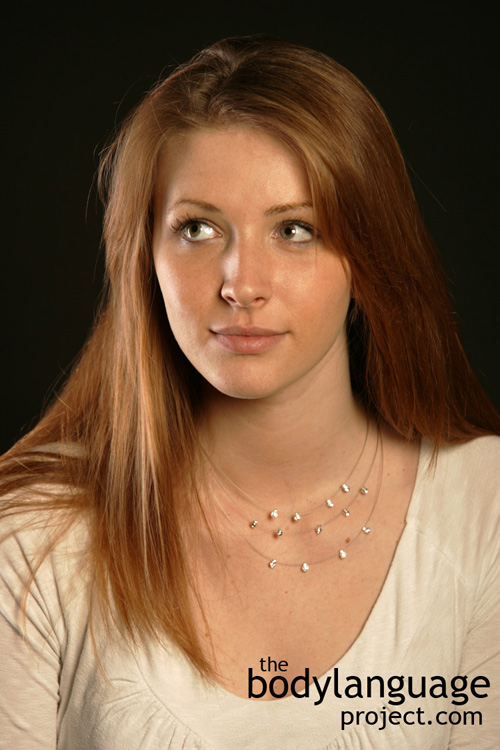what does looking down and to the right mean
Torso Language of Looking To The Right

Synonym(s): Centre Admission Cues
Clarification: Looking to the correct.
In One Sentence: Looking to the right signals that a person (correct handed) is accessing an honestly remembered visual thought (they aren't lying).
How To Use it: This is a cue that is used past reading it in other people. Just watch how eyes motility while thinking in social club to assess which sorts of memories are being accessed. For this to be effective, one must outset verify the cue's accuracy by baselining in outset. In nigh normal right handed people, looking right signals that a person is recalling a visual idea.
Researchers take noted that looking in i management while thinking is not always reliable.
Context: General.
Exact Translation: "I'thou looking to the right and up to recall a visual thought, correct and level to recall a sound and right and down to talk to myself or think of a kinesthetic thought."
Variant: Meet Looking To The Left. The opposite will be the case for left handed people. Make sure you lot baseline this cue to decide is truthful accuracy on a case-by-instance basis.
Cue In Action: When trying to come up upward with a story for why she was out so belatedly, she looked up and to the right. Based on her eye admission cue, her Dad had caught her thinking about what actually happened. He had a hunch that she was telling the truth.
Pregnant and/or Motivation: Looking right (as you look at person) and up is a nonverbal cue that signifies that a visual thought is being accessed or remembered. In other words, a person is really trying to recall what actually happened indicating honesty.
Looking to the right (level) indicates that a sound is being remembered, while looking down and right indicates the access of kinesthetic thoughts, or that cocky talk is existence accessed.
Cue Cluster: North/A
Body Linguistic communication Category: Automated gesture, Eye Linguistic communication, Honest body language, Microgestures, Pensive displays.
Resources:
Beck CE, Beck EA (1984) Test of the Eye-Motion Hypothesis of Neurolinguistic Programming: A rebuttal of conclusions. Percept Mot Skills. 58: 175–176.
Dilts, R.B., Grinder, J., Bandler, R., & DeLozier, J. 1979. Neuro-linguistic programming 50 Cupertino, CA: Meta Publications.
Ekman P (2001) Telling lies. Clues to deceit in the market, politics, and union. New York: W. W. Norton & Visitor.
Elich M, Thompson RW, Miller 50 (1985) Mental imagery equally revealed past eye movements and spoken predicates: A test of neurolinguistic programming. J Couns Psychol 32: 622–625
Grey R (1991) Tools for the trade: Neuro-linguistic programming and the fine art of
communication. Fed Probat 55: 11–16.
Galin, D. and Ornstein, R., 1974. Private Differences in Cerebral Style – Reflective Eye Movements; Neuropsychologia, 12: 376-397.
Heap M (2008) The validity of some early on claims of neuro-linguistic programming. Skeptical Intelligencer 11: half dozen–13.
Levine TR, Asada KJK, Park HS (2006) The lying chicken and the gaze avoidant egg: eye contact, deception and causal order.
Porter S, x Brinke L (2010) The truth about lies: What works in detecting highstakes
deception? Legal and Criminological Psychology fifteen: 57–75.
Mann, Samantha ; Vrij, Aldert ; Nasholm, Erika ; Warmelink, Lara ; Leal, Sharon ; Forrester, Dave. The Direction of Deception: Neuro-Linguistic Programming as a Lie Detection Tool. Journal of Police and Criminal Psychology. 2012 27(ii): 160-166.
Levine TR, Asada KJK, Park HS (2006) The lying chicken and the gaze avoidant egg: eye contact, deception and causal order.
Porter Southward, 10 Brinke L (2010) The truth about lies: What works in detecting highstakes
deception? Legal and Criminological Psychology 15: 57–75.
Percival, Jennifer. Center-opener: neuro-linguistic programming aims to offer techniques to enhance our everyday lives. Jennifer Percival attended a course to detect out more.(perspectives). Nursing Standard. 2003 18(1): 20(2).
Patrington. 1997. NLP for Business concern Success: How to Master Neuro-Linguistic Programming. Management Inquiry News. xx(eight): 43.
Panksepp, J. 1998. Melancholia Neuroscience: The Foundation of Human being and Animal Emotions. Oxford Univ. Press, New York.
Sandoval. 2001. Subtle skills for building rapport: using neuro-linguistic programming in the interview room. FBI police enforcement bulletin. 70(eight): 1-635.
Skinner. 2003. Speaking the same language: the relevance of neuro-linguistic programming to effective marketing communications Source: Journal of Marketing Communications. 9(3): 177-192.
Sharpley CF (1984) Predicate matching in NLP: A review of enquiry on the preferred representational system. J Couns Psychol 31: 238–248.
Sharpley CF (1987) Research findings on neurolinguistic programming: Nonsupportive data or an untestable theory? J Couns Psychol 34: 103–107.
Tosey, Paul; Mathison, Jane; Michelli, Dena. 2005. Mapping Transformative Learning: The Potential of Neuro-Linguistic. Journal Of Transformative Teaching. 3(2): 140-167.
Roderique – Davies, Gareth. Neuro-linguistic programming has no basis in neuroscience.(Messages)(Letter to the editor). Nursing Standard. 2010 24(33): 33(1).
Thomason TC, Arbuckle T, Cady D (1980) Exam of the Eye Motion Hypothesis of Neurolinguistic Programming. Percept Mot Skills 51: 230.
Vrij A (2004) Invited article: why professionals fail to take hold of liars and how they can better. Leg Criminol Psychol 9:159–181
Vrij A, Lochun SK (1997) Neuro-linguistic programming and the police: worthwhile or not? J Police Crim Psychol 12:25–31
Vrij A, Lochun SK (1997) Neuro-linguistic programming and the police: Worthwhile or non? Journal of Police and Criminal Psychology 12: 25–31.
Wiseman, Richard ; Watt, Caroline ; ten Brinke, Leanne ; Porter, Stephen ; Couper, Sara-Louise ; Rankin, Calum Lappe, Markus (Editor). The Eyes Don't Have Information technology: Prevarication Detection and Neuro-Linguistic Programming (The Eyes Don't Have Information technology). PLoS One, 2012, Vol.7(vii), p.e40259.
Wood, John Andy 2006. NLP revisited: nonverbal communications and signals of trustworthiness. Journal of Personal Selling & Sales Management. 26(2): 197.
Source: http://bodylanguageproject.com/nonverbal-dictionary/body-language-of-looking-to-the-right/
0 Response to "what does looking down and to the right mean"
Postar um comentário